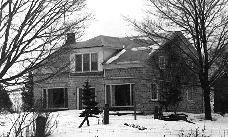Don’t buy that old house
— not if it has any historical or architectural merit. Let it die gracefully amidst
the shady maples and crowding lilacs. That is, unless you are that rare species of owner
whose restoration would be harmonious with the aims of the original builder.
But
too often is an early 19th-century house bought by “city” people, in search of
the proverbial “old stone house”, unhappily destined to become a bastard
composition of half old, half new; half country, half city. Out come the old small-paned
windows, and on go the aluminum storms. Picture windows reign triumphant (right).
Off comes the old cast or wrought iron hardware, and on go the new “rustic”
artsy-craftsy hinges, which take up half the door.
In
rooms where delicate mantel mouldings complemented the painted walls and trim, now raw new
pine covers up all traces of the glowing rose colors, blue-grey trims, and gay foliage of
the old wallpaper. In our enthusiasm for those “pioneer” days, we have forgotten
that most of our existing old houses are post 1812 War, in a day when bare wood panelling
had been out of style for 60 years or more. Where split lath and plaster had discreetly
covered up the rafter and joist construction of the ceiling, we expose it and call it
“open beam”. A Regency gentleman, haunting his 1830 home in 1971, might quickly
yearn for the grave again.
Tired
of modern mass-produced high-rises and prefabs, we long for an old lived-in home. Yet the
first thing we do upon achieving our dream is to plane smooth all those wear marks on the
house. We sand down all the floors, and remove the bumps and signs of human habitation,
until we get the surface of “straight from the factory” pine boards.
Forgetting
that spinning wheels were relegated to the upper hail or attic, we sit it out on the front
lawn, only to complement the wagon wheel fence, a feature which our ancestors never
dreamed of.
I
don’t mean to suggest I am advocating 19th-century living at least, not totally. The
benefits from central heat over fireplaces and woodstoves can be attested to by anyone who
has sat in front of a raging fire, and roasted his front, while freezing his back. Not to
mention the questionable value in those early morning nature excursions to the privy in
our Canadian winters. But one should consider the best type of heating system for an old
house. At least with electric heat, you are not tempted to add those awful brick exterior
chimneys to get rid of the fumes from a furnace. The bathroom can be discreetly located in
a less important room, such as a storeroom or small bedroom.
In
rooms which once glowed with the soft flickering light of candles, fire places or oil
lamps, we unmercifully illuminate with fluorescent or over head light. Electric table
lamps can be much more pleasant to eat by or to converse by, due to their softer lighting
effect.
If
you do have the privilege and pleasure of redoing an old house, go slowly. Initial
enthusiasm can destroy all signs of unusual features of the house, such as the original
floor lay out, bake-ovens stenciled walls, and so on. Try to assimilate the aspirations of
the original owner. Was his mood predominantly folk-builder tradition, neoclassic, Regency
or Victorian? How was this expressed in his building?
While
we are willing to invest thousands of dollars in an old house, as we are impressed by the
rising value of all things antique, we are not willing to invest the time in doing proper
research on the period of the house, or to invest the money in hiring a sympathetic
restoration designer to advise us.
Therefore,
do not invade the countryside with your sheets of knotty pine to rape and plunder, but
rather let those once proud country seats die inviolate.
________________________________
This article was published in Weekend Magazine,
Montreal, Issue 46, 20 November 1971 |